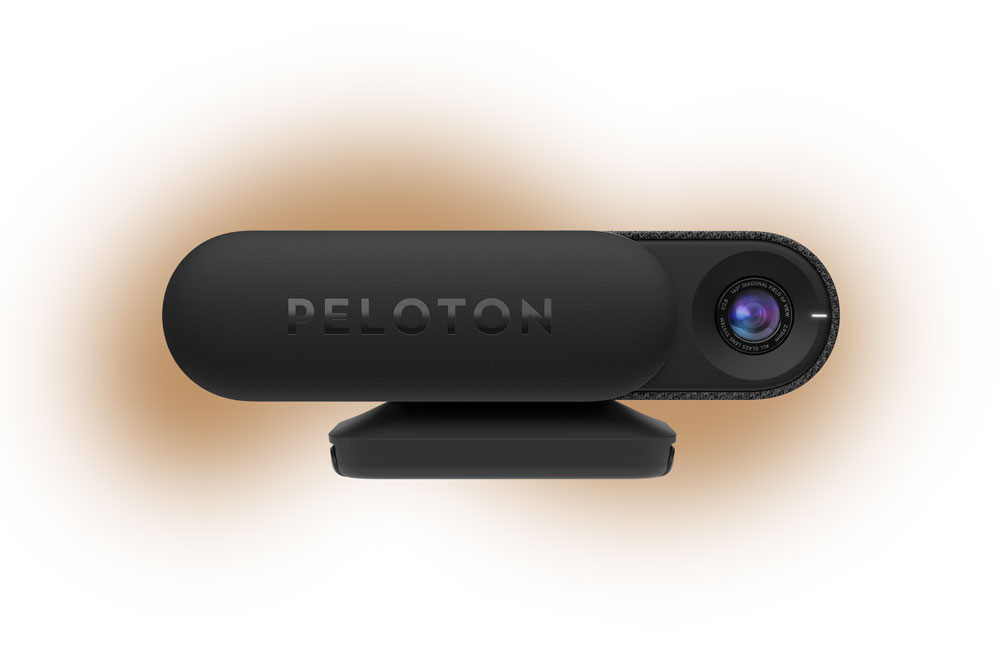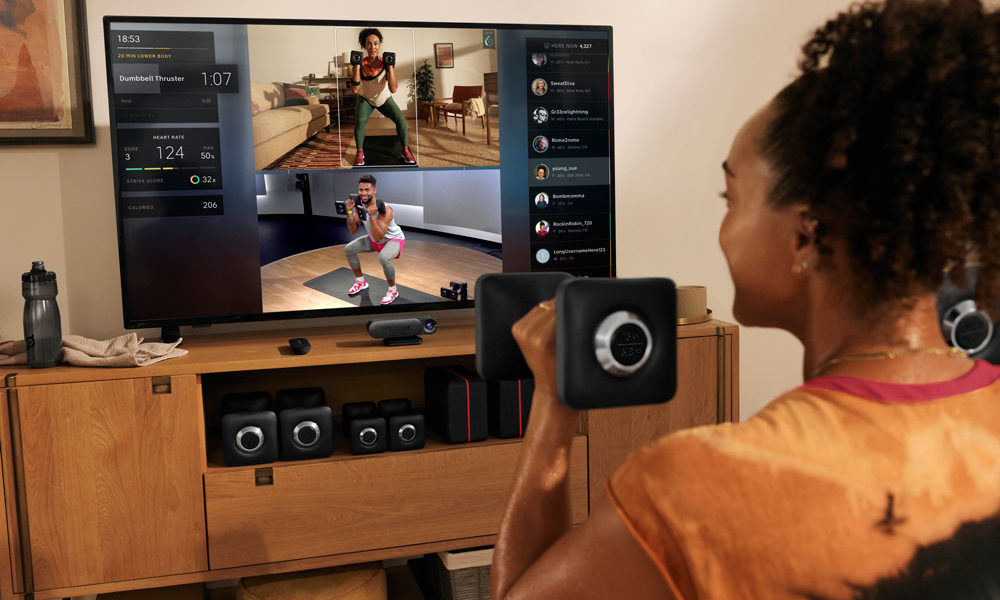Remember the days of virtual workouts when you could take it easy? You could skip a move with no one noticing? Or you could go into savasana as the trainer on the screen moved on to the next exercise? According to Peloton, those days are gone. Thanks to the launch of the Peloton Guide in Canada. Peloton is calling on you to step up your accountability. It wants you to be your own Form Police with its latest equipment launch. I got an early look at Peloton Guide launching in Canada, and here’s what I learned.
Virtual Workouts Vs IRL: Which way to exercise is more effective?
What is the Peloton Guide?
It’s like a mirror, a personal trainer and a motivational tool all in one. Its retro design harkens back to the 110 cameras with a lens slider cover. But it’s dressed up with rounded lines to sit unassumingly on top of your TV. It has a camera that tracks your movements and streams your image right in front of you. As you follow the instructor, you can see yourself on our TV (options include large, small, side-by-side, stacked or not all). During my one-on-one demo, I’m shown how to look at my form and compare myself with what the instructor is doing. Guide comes with six sets of dumbbells (5 to 50 pounds), a HRM and a mat for $1,215 for the top package. You also get access to live strength classes and pre-recorded strength workouts, and both offer motion tracking. Plus, there’s the extensive library of other classes Peloton’s known for, including cardio, yoga, meditation, et al.
Hands down, the easiest fix for wrist pain during push-ups, planks and more
What does Peloton do with your Guide videos?
Nothing, apparently. Guide doesn’t store or transfer your videos outside of the unit to TV streaming, Irene Lee, product manager, Peloton Interactive, tells me over a Zoom demonstration from Boston. It’s not streamed to other users. And you can’t access them after your workout is done.
“Consumers have been very attentive to privacy,” she says. “Our solution to this is this hard cover here.” She then slides the Peloton-glossed-and-embossed panel over the lens. “We don’t want anyone to feel any uneasiness. And, likewise, we have a microphone switch on the back. You know when you want privacy, you truly have it.”
The role of the camera is to also give you “sweat” points. It tracks and recognizes your movements for each exercise. (It looks like the Peloton P logo but turned upside down in the shape of a sweat droplet.) And if you’ve used the bike or treadmill, you will see the familiar intensity zones based on your heart rate as you work out too. You can also do modifications or advance the moves, and the tracker is said to recognize that too.
“It’s so exciting that members will now get credit for doing an interval to completion,” Peloton Interactive instructor Jess Sims tells me via email. “I am also happy that members can look at the body activity tracker percentages to make smart decisions about their next workouts based on what their body needs.”

The best gyms in Toronto: Where the city’s fitness pros work out.
Setting it all up
The Peloton Guide is pretty easy to set up. But before you even plug it in, you’ll want to set up your space. You don’t just need room to work out. (I use a yoga mat to ensure I have the floor space to do floor work, and headroom above to jump.) You must also ensure that your area is big enough for the camera to capture you as you move around–4.5 by 6 feet of unobstructed views for the camera.
Of course, you will also need a TV to view the classes and yourself.
You attach the unit to your TV via an HDMI cable and plug into a wall outlet. It’s not unlike Apple TV (how I used to access the Peloton app). Sit it on your TV unit, fireplace or any flat surface under your TV. You can also put it on top of the TV, if that’s better framing or you have your tele mounted to the wall. It comes with an adjustable L-shaped magnetic stand for just that.
The camera uses artificial intelligence (AI). You’ll see a moving square around your body as you exercise. It can also zoom the focus in and out, should you go from the floor to standing. It reminds me of the facial recognition tool on Facebook when you’re asked to tag friends. But obviously, it’s intuitive to motion.
My Guide needed an update and I wasn’t able to immediately pair the Armband heart rate monitor (HRM). But with a quick visit to peloton.ca to chat with technical support, and I was able to pair it less than a few minutes later. (Customer support for cell and wifi companies listen up – that’s how you deal with customers.)
The Peloton Guide also comes with a hand remote and (in beta) voice controls. “It‘s workout proof,” says Lee, adding that the remote is sweat-proof and durable, in case you step on it, too. “Training is mentally and physically taxing. So, it’s one less thing to worry about.”
With a tap of a button or saying, “OK Peloton,” you can skip a move that you can’t do. Whether that’s for injury reasons or even energy reasons, no judgement from me either way.
This inexpensive piece of fitness equipment will make you fall in love with squats.
How to work out with Peloton with an injury
I have a shoulder issue and I’ve taken a few months off the strength workouts with Peloton. Partly because I felt guilty about sitting out of certain moves while my screen pushed on through the workout. The ability to modify and skip past moves I can’t do is very exciting for me rn. (I’m working with a physiotherapist and consulted with a kinesiologist to know what exercises I can and can’t do.)
To check modifications, the instructor will lead you through that in the workout on screen. But you can also check for the exercises and tap for modifications (via the “related movements”) before you even hit start.
“Modifications are for everyone — not just if you have an injury,” says Sims. How do you know when it’s time to modify? “It’s that moment where you need to check your pride and say, ‘hmm I’m not there yet, but I am going to modify it so that I can get stronger and get there soon.’ A key sign that you might need to modify is if you’re not getting the full range of motion, like pulsing push-ups instead of going further down, or if you’re feeling any pain. Modifications can mean altering the movement but it can also mean slowing down, dropping down in weight or dropping the weights completely.”
And in my case with overhead motions, I just hit the skip button.
How to use Peloton if you need more of a challenge
There have also been times when I’m like, damn, I wish I’d chosen something more intense. And just as noted above for checking for modifications, you can also check for advancing moves. Sims says: “A lot of times in a strength class, you can advance a movement by adding more load, a.k.a. heavier dumbbells. Advanced is not a one size fits all, so it’s important to not put too much pressure on yourself and only go heavier in areas where you’re ready to be pushed.”
You can also increase heart rate by going faster – only if your ability to maintain proper form allows it. Moving slower, with a longer count, on the contraction part of the move, can increase your endurance for a lift, too. Another option, stack your workouts or add a quick cardio workout as a finisher. Many of the strength workouts include an AMRAP (as many rounds as possible) mini session at the end, which is another good way to challenge yourself even more.
Should you do the “50 crunches a day for 30 days” challenge?
Who is it perfect for?
Should you buy it? If you’ve been wanting to try Peloton for accountability and don’t want the investment of a bike or a treadmill, the $395 price point (plus $49 a month) is an easier charge on the credit card.
I think it would also be good for Canadia Peloton members who want more from their strength workouts. That means more accurate measures of calorie burn, intensity and HRM metrics. That does mean an upgrade for current members, including app, bike and treadmill owners.) I’d also recommend it to those who aren’t ready to hit the gym and those who want better strategy with their workouts. Guide tracks the body parts targeted for the week, and you get class suggestions based on that. Pretty genius. I usually play workout roulette – just see what my favourite instructors have recently listed in the app.
As for me, I’ve been able to do a couple of workouts with it before writing this article. Seeing the points was pretty cool. But I will be doing a full review when I’m able to fully take advantage of the Peloton Guide… stay tuned.
July 2022 update: My full review of Peloton Guide.
What are the newest features for Peloton Guide?
Artificial intelligence (AI) for fitness is an interesting new trend for workouts. It ensures that our form is right and that all our reps are counted. And it makes sense that Peloton steps up its game and puts its AI hat in the ring. And since the launch in April 2022, Guide has the following new features:
- Your reps are getting tracked – finally! It’s just just about sweat points anymore. And as you reach the targets for every round, Guide will tell you are on a streak. It’s the extra motivation to push out those last reps as you tear through the workout. Plus, this rep counter feature works like a fitness journal. It saves your stats from class-to-class, so you know when you’re getting stronger.
- Set your weights before your workouts. Just log in what you’ll be using for light, medium and heavy. This data will also help you gauge if you’re getting stronger based on the weights you use.
- Three new Guide programs: 1. The Century is planned to help you achieve a total of 100 reps of your favourite movement before class ends; 2. Pump Up The Volume is a four-week class plan that will work you to increase your weights and/or reps; and 3. Rep It Out is a group of quick and dirty classes where you complete “as many reps as possible.”

